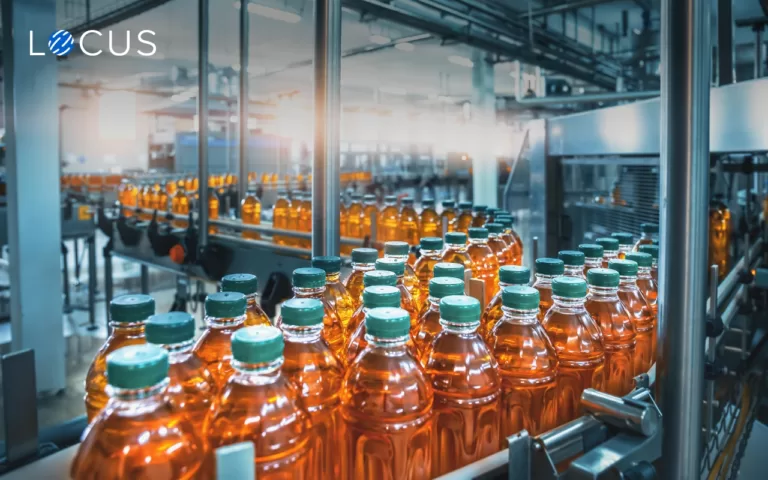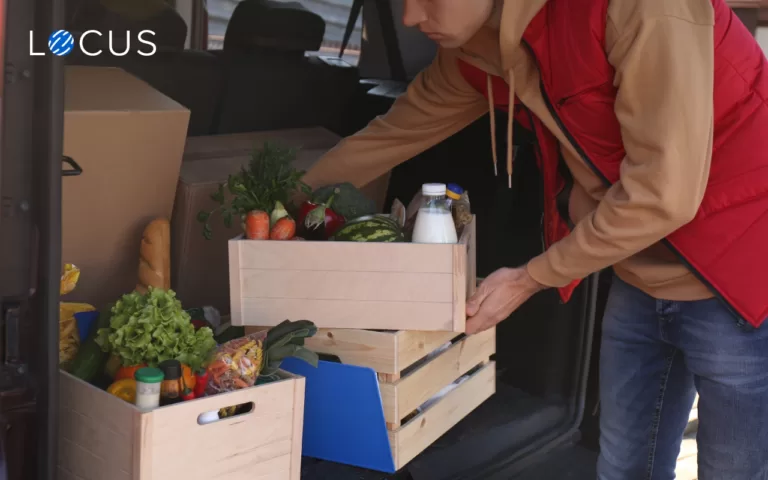E-Commerce
How Delivery Logistics Software Benefits F&B Brands in their D2C Logistics Operations
Aug 26, 2021
9 mins read

The Food and Beverage (F&B) industry has been one of the most untapped categories in the direct-to-consumer (D2C) marketplace. Since the start of the coronavirus crisis, F&B products have gained significant traction on e-commerce platforms. With goods going regularly out-of-stock in stores, consumers have been forced to use digital channels to fulfill their product needs.
Parallelly, stockpiling, panic buying and long supermarket queues have also become regular. Due to these reasons, foot traffic in stores has been reducing drastically and has resulted in a huge number of customers using various e-commerce marketplaces.
In the beginning, consumers started purchasing from e-commerce market places like Amazon. But their limited delivery spots have led to consumers purchasing directly from F&B D2C brands. This makes it imperative for many F&B brands to build their digital footprint and D2C logistics capabilities for the future.
Why are F&B brands investing in D2C e-commerce and logistics?
D2C has gained popularity among the top F&B brands owing to the pandemic restrictions resulting in minimal foot traffic in retail outlets. Recently, leading brands like Pepsico, Nestle, and Kraft Heiz etc are establishing and expanding their D2C services. This has helped them personalize their customer experience without much help from brick-and-mortar stores.
Find out why F&B brands are increasingly investing in Direct-to-Consumer.
Eliminates intermediaries
Traditionally, F&B brands used offline distribution channels like distributors, retailers or super stockists. Using multiple offline channels results in inventories piling up and causing inefficiencies in their logistics distribution. Today, many e-commerce marketplaces act like retail channel for many brands. This stops F&B brands from getting to know their customers directly.
With D2C e-commerce, brands can free themselves from the clutches of the traditional distribution channels, bypass their intermediaries, directly interact with their customers, and understand their needs better.
Improves the products’ speed to market
Prior to the onset of the coronavirus, many F&B brands were not very serious in implementing D2C e-commerce business models. Hence, their speed to reach the market with a wider customer base was lesser.
With the D2C business model, F&B brands are able to forgo the complexities that come with offline models like wholesale and distribution. This helps them move their products quicker and build a positive rapport with customers.
Improved ownership of customer data
Data has now become the guiding force for many F&B businesses to optimize their distribution networks and improve their logistics operations.
Adopting a D2C business model helps F&B brands own their data compared to traditional distribution models where data is siloed and incomplete. This ownership in holistic customer data helps them enhance their customer relationships through its insights.
Greater control over customer experience
The massive difference between normal businesses and reputed brands is in consistently building a positive customer experience as it improves customer relationships and builds a powerful brand reputation over time. In order to build a positive customer experience consistently, it is important to have better control over the customer experience.
D2C gives F&B brands ownership over customer relationships rather than surrendering them to third-party retailers. It ensures that customers need not rely entirely on traditional retail stores. With D2C, F&B brands can cultivate brand loyalty through their premium priced product lines. This also helps them collect first-party customer data to personalize their customer experience.
Making data-driven business decisions effectively
Earlier, with traditional distribution channels, F&B brands faced difficulty in introducing their new products to the market as they would go through numerous trial and errors before getting introduced to a larger audience base, leading to high costs.
With the advent of D2C, F&B brands are facing a newfound advantage in marketing their new products. They can now test their new products in D2C before they can introduce them to the offline market. This minimizes the experimentation and distribution costs for their new products. The data insights gathered from it comes in handy during their major offline product launches.
Earlier, businesses feared that D2C would separate them from the customers visiting physical stores. With new modes of omnichannel fulfillment like buy online, pick up in store (BOPIS), D2C selling can bridge the distance of customers shopping amid pandemic restrictions and physical stores. It also provides a favorable advantage to F&B businesses in effectively making data-driven decisions whether from the product or the distribution front.
How does delivery logistics software benefit F&B brands in their D2C logistics operations?

In the age of on-demand deliveries where customers want the quickest delivery times possible, the D2C business model has stood the test of time. With the intention to streamline their delivery processes, F&B brands have started investing more in D2C services.
Given today’s express delivery demands from customers, it is not easy for them to build their D2C logistics capabilities. It is a long term process that yields dividends after consistent delivery performances. To achieve this, it is necessary for F&B brands to invest in delivery logistics software.
Find out how investment in delivery logistics software helps F&B brands improve their profitability in D2C logistics.
Improves transparency and visibility
A brand that wants to be successful in D2C operations should nurture its customer trust and follow their service level agreements (SLAs) strictly. Transparency and visibility are two major components for F&B businesses that determine its brand loyalty. Failure to improve this results in uncertain, inaccurate and lengthy delivery processes.
Real-time tracking software is really helpful in monitoring the current location of shipments and their present condition. It makes it easier for fleet managers to keep a detailed and updated track of their drivers and shipments. This helps them largely to improve their fleet utilization and boost their efficiency.
Effective end-to-end communication
Communication is the most essential element for the success of delivery operations. F&B brands are facing this challenge since they started adopting the D2C business model in their logistics. Poor communication internally with stakeholders and externally with customers results in a higher percentage of delivery failures.
An effective end-to-end communication is the basis for strong coordination to take place between field staff and fleet management. A delivery logistics software, with its accessible dashboard, helps fleet management monitor their delivery operations on a micro and macro level. With its transparent alerts and notifications, it enables drivers to easily accommodate their ad-hoc deliveries without disturbing their high-priority deliveries.
Efficient delivery allocation
F&B brands struggle to deal with the complexity of orders, leading to inefficient order management. It is necessary for them to maintain accuracy in allocating orders after factoring real-time dispatch challenges. Manually allocating delivery tasks is a time-consuming process and it adversely affects the productivity of the fleet.
A delivery logistics software helps F&B brands to monitor products from the warehouse to the customers. It helps them accommodate shipments of all sizes, and allocate them to limited resources without burdening them. Its auto-allocating system helps fleet managers to easily find the most suitable drivers after factoring various delivery requirements and constraints. This makes dispatching quick, efficient and accurate, thereby eliminating the need for additional staff overheads.
Optimal route plans
Delivery routes are growing complex with every passing day and this takes a toll on the profit margins of F&B brands. Inefficiencies in picking up the right routes makes it difficult to execute multiple deliveries successfully. This maximizes the number of failed deliveries and increases last-mile delivery costs considerably.
Using delivery logistics software helps F&B brands or their logistics partners set up cost-efficient shipping routes. It provides fleet drivers with the most optimal routes that help them complete maximum number of deliveries by covering a minimal distance. This helps them reduce the average delivery time causing an increase in repeat customers rate, thereby leading to increased revenues.
Real-time performance data
Whether it is tracking customer requests or keeping delivery records, F&B brands do face issues. They require past and present delivery performance data to analyze them and devise efficient delivery schedules. The absence of this data leads to irregular planning thereby affecting the fleet productivity.
With delivery logistics software, F&B brands can easily analyze their past and present delivery records. It helps them easily identify and solve the issues that result in delivery failures. It enables them to find out the route irregularities by matching the planned and actual routes of the fleet.
Data from delivery logistics software helps drivers comprehensively analyze drivers’ performances in real-time. Its detailed history of delivery tasks help them to reduce their idling rate, wait times, vehicle downtimes, missed deliveries or delayed deliveries. These analytical insights help them to maintain their efficiency, delivery standards and their productivity.
Conclusion
F&B brands transitioning into D2C logistics operations have their task cut out for them when it comes to sustaining their brand reputation. In this grim situation, they are looking to expand their product offerings and improve their customer service. They face a massive challenge in elevating their customer experience by keeping costs down. Countering this challenge requires a tool like delivery logistics software from a trusted tech partner.
Locus specializes in providing delivery logistics software that suits the various logistics needs of modern F&B businesses. Its dynamic route recommendations help fleet drivers maintain their on-time delivery performance consistently. Its real-time tracking capabilities help fleet managers rectify delivery issues and improve their delivery success rate.
Begin your D2C journey with our locus offerings- click here to schedule a demo!
Related Tags:

E-Commerce
Embracing the Change: How E-commerce is a Game Changer for the Food & Beverage Industry
The food and beverage (F&B) industry is unique as its goods have a short shelf life, which introduces time sensitivity in the supply chain. A small window for consumption makes the quick and seamless flow of goods, right from marketing to delivery vital, but tricky. As supply chains evolve and new trends keep sprouting up, […]
Read more
Retail & CPG
Food & Beverage Distribution: Trends, Challenges, and Tech
Since the onset of the COVID-19 crisis, the global food and beverage (F&B) industry has seen some massive highs and lows. Unlike some industries, this one has grown significantly amidst the pandemic. The market, which includes the production, processing, packaging, and distribution of fresh, prepared foods, packaged foods, as well as alcoholic and non-alcoholic beverages, […]
Read moreMOST POPULAR
EDITOR’S PICKS
SUBSCRIBE TO OUR NEWSLETTER
Stay up to date with the latest marketing, sales, and service tips and news


How Delivery Logistics Software Benefits F&B Brands in their D2C Logistics Operations